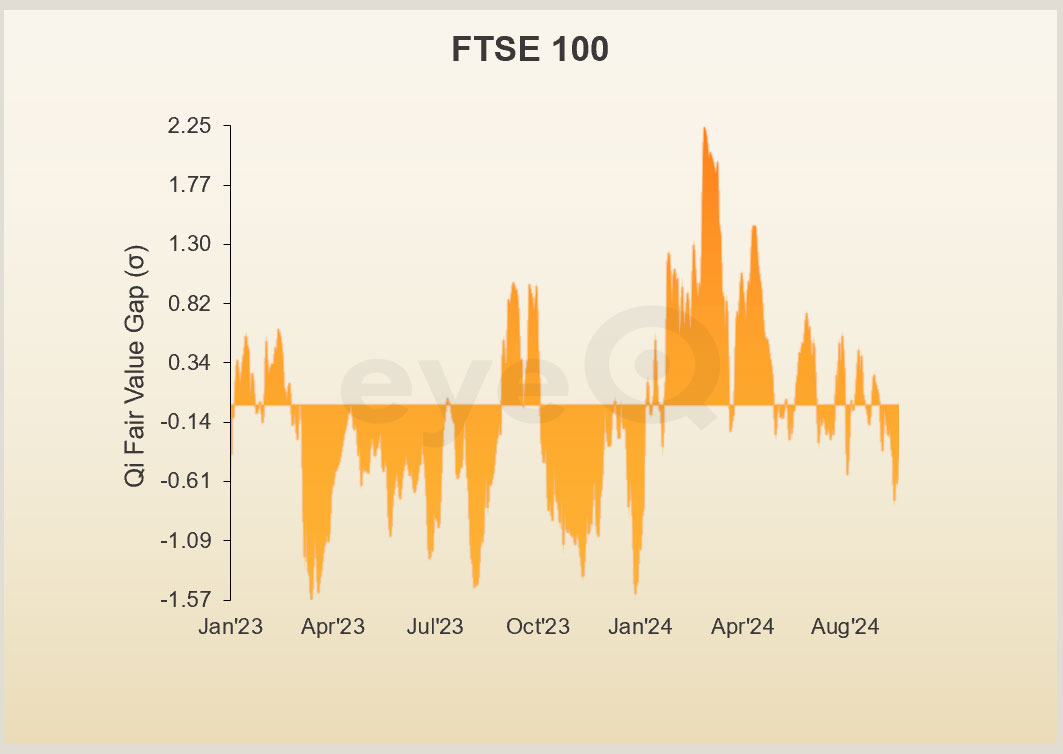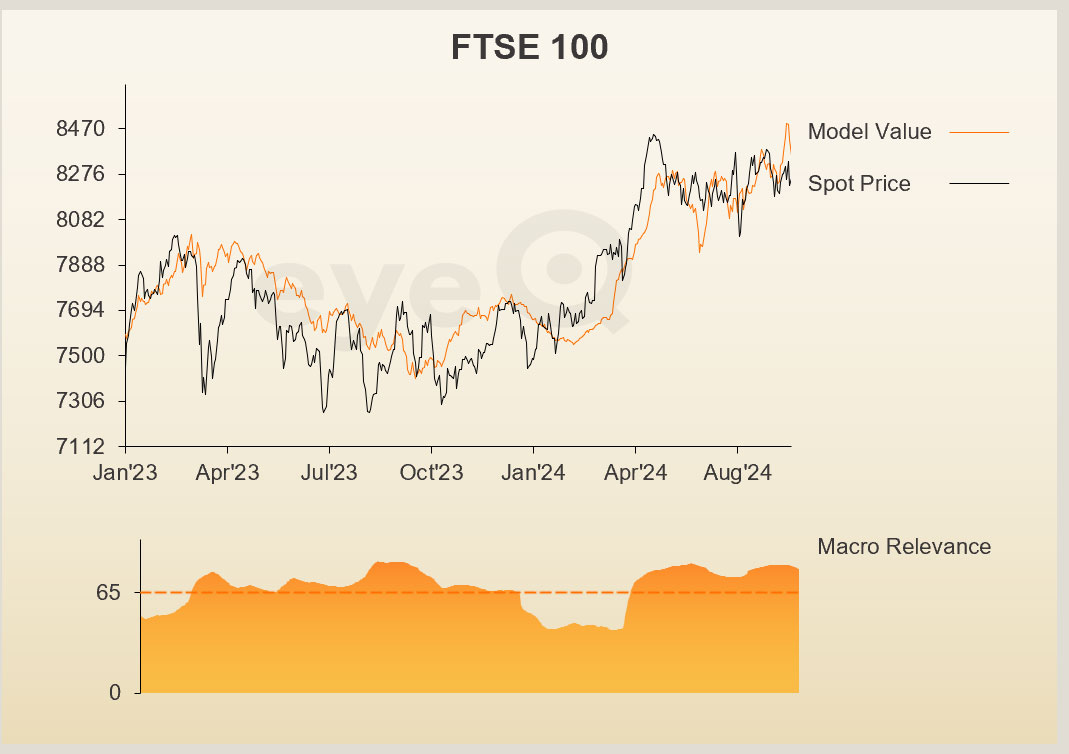eyeQ: new outlook for ‘cheap’ FTSE 100
Experts at eyeQ have used AI and their own smart machine to analyse macro conditions and generate actionable trading signals. Here’s its verdict on the UK’s top stock index.
24th September 2024 09:36
by Huw Roberts from eyeQ

"Our signals are crafted through macro-valuation, trend analysis, and meticulous back-testing. This combination ensures a comprehensive evaluation of an asset's value, market conditions, and historical performance." eyeQ
- Discover: eyeQ analysis explained | eyeQ: our smart machine in action | Glossary
FTSE 100
Macro Relevance: 80%
Model Value: 8,355.13
Fair Value Gap: -1.16% discount to model value
Data correct as at 24 September 2024. Please click glossary for explanation of terms. Long-term strategic model.
The big news this morning comes out of China. Its economy has struggled to recover since re-opening after Covid lockdowns and several attempts at policy stimulus have failed to hit home.
Overnight, Beijing have launched several measures which many financial commentators perceive to be the big-policy bazooka that’s been missing – rate cuts for banks and mortgage borrowers, direct support for the equity market.
Such are the long-standing issues facing the Chinese economy that there is no single silver bullet that will produce an immediate economic recovery. But, as statements of intent go, this is a strong sign that the authorities are finally stepping up.
How should ii customers think about this? The interactive investor platform has a number of Chinese funds. But remember that the UK equity market contains mining stocks such as Rio Tinto Registered Shares (LSE:RIO), Anglo American (LSE:AAL), and Antofagasta (LSE:ANTO), which could be among the main beneficiaries.
On eyeQ, all three of those are close to model value, i.e. they’ve been performing as they should given overall macro conditions. If these measures to stimulate Chinese growth gain traction, that model value will start to move higher.
Simpler still is the FTSE 100 itself. Last week, the Federal Reserve cut interest rates. In previous cycles that’s been a signal for the rest of the world to catch up with expensive US stocks; a signal that “value” plays can catch up to technology names.
After a strong start to the year, model value for the FTSE 100 has been rangebound for a few months now. It has felt like the market is waiting for next month’s Budget to decide which way the next big move will be.
Domestically, the Budget will be critical. But remember the FTSE 100 has a strong international bias and, while the Valuation Gap is modest, current levels do screen as cheap to the overall macro environment on eyeQ.


Source: eyeQ. Past performance is not a guide to future performance.
Useful terminology:
Model value
Where our smart machine calculates that any stock market index, single stock or exchange-traded fund (ETF) should be priced (the fair value) given the overall macroeconomic environment.
Model (macro) relevance
How confident we are in the model value. The higher the number the better! Above 65% means the macro environment is critical, so any valuation signals carry strong weight. Below 65%, we deem that something other than macro is driving the price.
Fair Value Gap (FVG)
The difference between our model value (fair value) and where the price currently is. A positive Fair Value Gap means the security is above the model value, which we refer to as “rich”. A negative FVG means that it's cheap. The bigger the FVG, the bigger the dislocation and therefore a better entry level for trades.
Long Term model
This model looks at share prices over the last 12 months, captures the company’s relationship with growth, inflation, currency shifts, central bank policy etc and calculates our key results - model value, model relevance, Fair Value Gap.
These third-party research articles are provided by eyeQ (Quant Insight). interactive investor does not make any representation as to the completeness, accuracy or timeliness of the information provided, nor do we accept any liability for any losses, costs, liabilities or expenses that may arise directly or indirectly from your use of, or reliance on, the information (except where we have acted negligently, fraudulently or in wilful default in relation to the production or distribution of the information).
The value of your investments may go down as well as up. You may not get back all the money that you invest.
Equity research is provided for information purposes only. Neither eyeQ (Quant Insight) nor interactive investor have considered your personal circumstances, and the information provided should not be considered a personal recommendation. If you are in any doubt as to the action you should take, please consult an authorised financial adviser.
Disclosure
We use a combination of fundamental and technical analysis in forming our view as to the valuation and prospects of an investment. Where relevant we have set out those particular matters we think are important in the above article, but further detail can be found here.
Please note that our article on this investment should not be considered to be a regular publication.
Details of all recommendations issued by ii during the previous 12-month period can be found here.
ii adheres to a strict code of conduct. Contributors may hold shares or have other interests in companies included in these portfolios, which could create a conflict of interests. Contributors intending to write about any financial instruments in which they have an interest are required to disclose such interest to ii and in the article itself. ii will at all times consider whether such interest impairs the objectivity of the recommendation.
In addition, individuals involved in the production of investment articles are subject to a personal account dealing restriction, which prevents them from placing a transaction in the specified instrument(s) for a period before and for five working days after such publication. This is to avoid personal interests conflicting with the interests of the recipients of those investment articles.